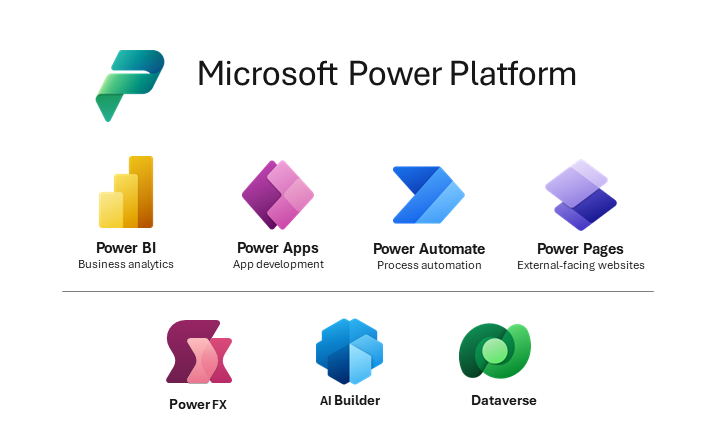Explore Microsoft Power Platform
The Power Platform provides organizations with the opportunity to empower their team members to build their own solutions through an intuitive low-code or no-code set of services. These services help simplify the process of building solutions. With Power Platform, solutions can be built in days or weeks, as opposed to months or years. Microsoft Power Platform is composed of four key products: Power Apps, Power Automate, Power BI, and Power Pages.

Microsoft Power Apps
Power Apps provides a rapid low code development environment for building custom apps for business needs. It's a suite of apps development services with a scalable data platform (Microsoft Dataverse) and an ability to interact with cloud & on-premises data sources. Power Apps enables the creation of web and mobile applications that run on all devices.
People use mobile apps for every area of their lives, and business should be no exception. Most out-of-the-box solutions don't meet exact business needs or integrate well with other business programs. Power Apps eases users into app development with a simple interface, so that every business user or pro developer can build custom apps.
Microsoft Power Automate
Power Automate lets users create automated workflows between applications and services. It helps automate repetitive business processes such as communication, data collections, and decision approvals. Don't waste important productive hours on drafting the same email for a weekly update or manually walking through approval processes, Power Automate can provide automation not only for the individual user, but also for enterprise-grade process automation. Its simple interface allows users with every technical competence (from beginners to seasoned developers) to automate work tasks.
Microsoft Power BI
Power BI is a business analytics service that delivers insights for analyzing data. It can share those insights through data visualizations, which make up reports and dashboards to enable fast, informed decisions. Power BI scales across an organization and has built-in governance and security, to allow businesses to focus on using data more than managing it.
You can consider Power BI as the analysis and insights leg of The Power Platform. A Power BI dashboard could potentially replace a standing meeting to report on company metrics such as sales data, progress against goals, or employee performance.
Microsoft Power Pages
Microsoft Power Pages is a secure, enterprise-grade, low-code software as a service (SaaS) platform for creating, hosting, and administering modern external-facing business websites. Whether you're a low-code maker or a professional developer, Power Pages enables you to rapidly design, configure, and publish websites that seamlessly work across web browsers and devices. Power Pages provides you with rich customizable templates, a fluid visual experience through a reimagined design studio and an integrated learning hub to quickly build sites that suit your unique business needs.
Power Pages is the newest member of the Microsoft Power Platform family. With Power Pages, you can build sites by using the same shared business data stored in Microsoft Dataverse that you use for building apps, workflows, intelligent virtual agents, reports, and analytics with other Power Platform components in your organization.
Supporting tools
In addition to the products listed, there are other tools that enhance the solutions you create on the Power Platform. Some of these are:
Microsoft Copilot Studio is a low-code tool that brings together a set of powerful conversational capabilities from custom GPTs, to generative AI plugins, to manual topics, which can be used to customize Microsoft Copilot for Microsoft 365 and build standalone copilots.
Connectors enable you to connect apps, data, and devices in the cloud. Consider connectors as the bridge across which information and commands travel. Connectors are used by Power Apps, Power Automate flow, and logic apps. There are more than 1,000 prebuilt connectors for Power Platform, enabling all your data and actions to connect cohesively. Examples of popular connectors include Salesforce, Office 365, Twitter, Dropbox, Google services, and more.
AI Builder allows users and developers to add AI capabilities to the workflows and Power Apps they create and use. AI Builder is a turnkey solution that allows you to easily add intelligence to your workflows or apps and predict outcomes to help improve business performance without writing code.
Dataverse is a scalable data service and app platform, which lets users securely store and manage data from multiple sources and integrate that data in business applications using a common data model to ensure ease and consistency to users. Microsoft Dataverse is the common currency that enables the components of Power Platform to work together. It’s the foundation that enables the consolidation, display, and manipulation of data.
Power FX is the low-code programming language that is used across Power Platform.
Managed Environments are selected, secure, and isolated environments within Power Platform. Mananged Environments allow organizations to build, test, and deploy applications while maintaining control over data and resources.
Now that we introduced you to the primary elements of the Microsoft Power Platform, let’s examine how the Power Platform provides business value to organizations.